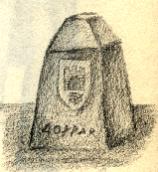[Imperial sizes]
[Surface]
[Distances]
[Contents]
[Weight]
Imperial sizes
For a very long time, each merchant in Daleth had his own sizes. If one ordered “an arms length of rope”, the merchant would ask the servant with the shortest arms to measure the rope. This got worse and worse, and most people loathed this, including the Emperor, who was the biggest buyer after all.So Emperor Hyzikh III decided to put an end to this in 1688. He had a sculpture made of himself, and a copy of this portrait was placed on every market square. The sizes of the Emperor’s body were then the only legal sizes. These sizes are still in use, but the statues have disappeared as Hyzikh fell from grace and was replaced by his second son, Hyzikh IV.
The sizes know in Daleth are now:
- a hair (not included in the statue, only used by scientists)
- a thumb (width) (=120 hairs)
- a finger (=3 thumbs)
- a (hand)span (= 3 fingers)
- a foot (=15 thumbs, =5 fingers)
- a pace (=3 feet)
- an arm (=1,5 feet)
- a man(span) or fathom (=3 pace, =9 feet)
There is also a size known as “a roede”, meaning “very small, almost nothing”. In dark alleys, voices whisper it is named after a slang word for a certain private part of the Emperors body, on the statue discretely hidden behind a piece of gold painted, cloth like marble.
Surface: gong and morning
 A Gongstone from Donvar that marks the borders of a Gong |
The gong provided was a standard instrument, which should be placed in a tower. During the years, cities found ways to enlarge the reach of the gong sound, only to raise more taxes. They made the towers higher, used acoustic technics to amplify the sound or changed illegally the gong itself.
In 1760 a standard gong area was prescribed by the Imperial government.
Farmers use the amount of field that can be harvested in one morning as a standard. There are different standard for each type of crop. The value of the field is close related to its size, and kind of crop. The kind of crop also dictated the date on which it had to be harvested, and with that, the size of a morning (or a stonde, for that matter).
With the introduction of the three-field-shifting agriculture, the amount of field that can be ploughed on spring morning has become the standard-standard, but farmers will use the old harvest-mornings as well. The afternoon was never used as a standard, because somehow the harvest of the afternoon was not as much as that of the morning.
Smaller surfaces are measured as “a square foot”, “a square thumb” and so forth.
Distances
Long distances are measured in “stondes to go” (see also the chapter [Time]) or “days to go”. On road signs the standard time to go is the time for a walking human to reach the place.On water, “stondes to sail” or “days to sail” are used.
Approximately, a human can walk about 15000 paces in a stonde. At least, this number is used for scientific studies.
The hvurtz is a distance of about a quarter of a stond.
Contents
Contents are also standardised by Hyzikh III. He ordered standard sets of cups and tons to be made. Now, in every (lawful) pub the glasses and cups are the same size. Wineglasses (“chalice”) are extremely large, because Hyzikh was a wine lover, and half-wineglasses are now more common.- a drop (only used by scientists)
- a sip (=20 drops)
- a cup (=12 sips)
- a chalice (=3 cups)
- a tankard (=1,5 cups)
- a bottle (=5 chalices)
- a cask (=20 bottles)
- a wagon (=20 casks)
Weight
The standard of weight is the gold-skatt-piece. This piece is not very heavy, and therefore the tehund-skatts (10 skatts) is more in use, commonly called the Tehund (or written: T. A sign with 2 Sk/T means something costs 2 skilliggs per Tehund).Related topics: